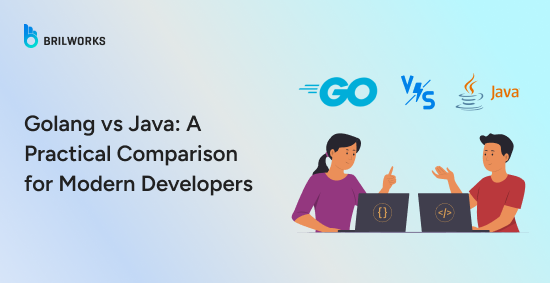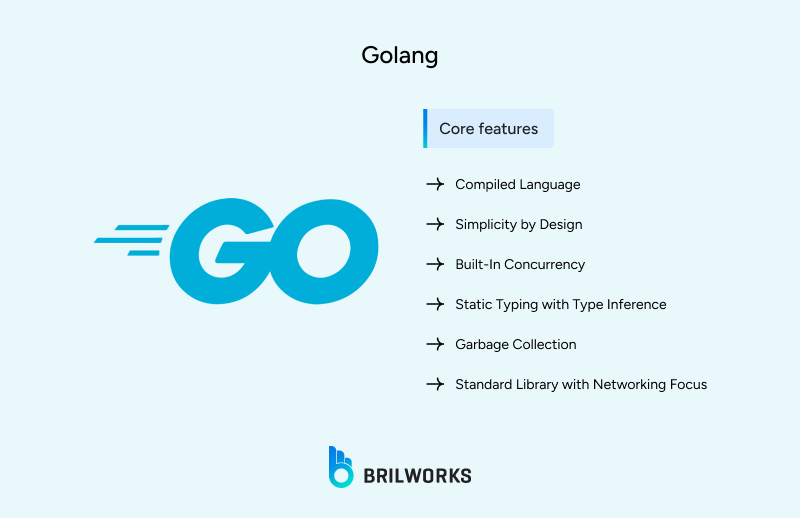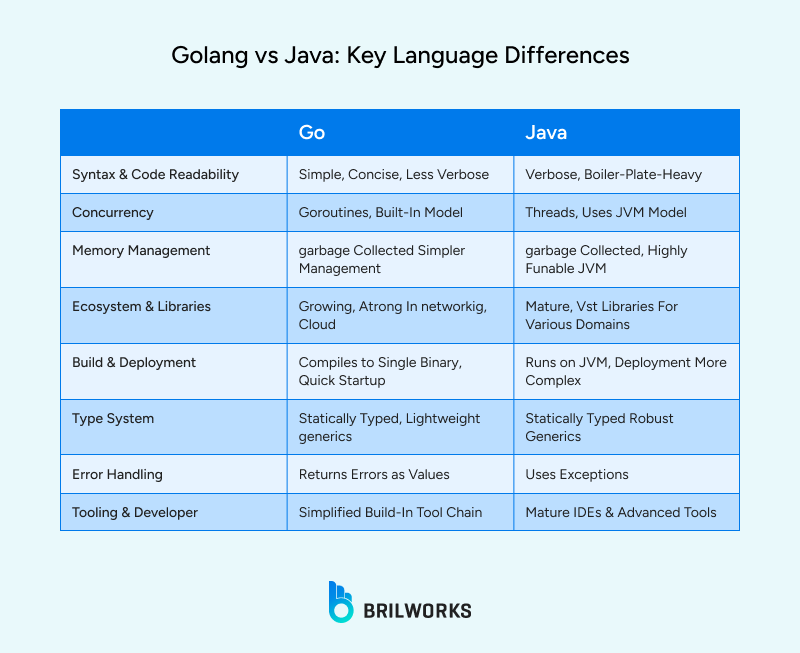COOPERATION MODEL
ARTIFICIAL INTELLIGENCE
PRODUCT ENGINEERING
DevOps & Cloud
LOW-CODE/NO-CODE DEVELOPMENT
INDUSTRY
FRONTEND DEVELOPMENT
CLOUD DEVELOPMENT
MOBILE APP DEVELOPMENT
LOW CODE/ NO CODE DEVELOPMENT
EMERGING TECHNOLOGIES








We recently wrote about Java vs Python and explored how both languages compare in terms of performance, learning curve, and real-world use. That comparison stirred up another familiar debate that developers face when choosing tools for backend development. Java vs Go. On paper, they do similar work. In practice, they take very different routes to get there.
Java has been around for over twenty years. It is stable, tested, and deeply woven into enterprise software. You see it in financial systems, telecom, and retail platforms. It is the kind of language that was built to last, and it has. The tooling is mature. The community is massive. The learning curve is steep at times, but once you are in, you are in for a while.
Go tells a different story. It was made to strip things down. The syntax is simple. The binaries are small. You do not need much ceremony to get started. It is the language you reach for when you want speed without noise. It is not a replacement for Java. It is more like an alternative path that appeals to a different kind of developer or project need.
In this blog, we will unpack the practical differences between Java and Go. Not just which one is faster or easier to learn, but how they behave in real-world projects. From concurrency and memory usage to use cases and long-term maintainability. Just what actually matters when it is time to choose.

Java is a general-purpose language that has been used in software development for more than two decades. It was created to let developers write code once and run it anywhere, thanks to the Java Virtual Machine. Over the years, Java became one of the main choices for large-scale systems, backend services, and enterprise platforms.
Java is built on the object-oriented model. It helps organize code into reusable pieces, making it easier to manage and maintain large projects over time.
Java code runs inside the Java Virtual Machine, which means it can execute on any device that supports the JVM. This removes the need to rewrite code for different operating systems.
Java enforces strict data types at compile time. This reduces the chance of runtime errors and improves code safety, especially in large applications.
Java comes with built-in garbage collection. Developers do not need to manually free memory, which helps prevent memory leaks in long-running systems.
Java includes features for handling multiple threads at once. This is useful in applications where performance and responsiveness matter, like servers and real-time systems.
Java provides a wide range of built-in libraries that cover networking, file handling, data structures, and more. This reduces the need for third-party tools in many cases.
Java has been around for a long time, which means most problems already have solutions. The ecosystem includes robust frameworks, tools, and best practices.
Thanks to the JVM, Java applications can run on different platforms without changing the code. This is especially useful in enterprise environments with mixed systems.
Java handles large-scale systems well. It is often used in projects that serve thousands or even millions of users. Its threading model and memory management help support high loads.
There is a large and active Java community. This makes it easy to find answers, libraries, tutorials, and other learning resources.
Java rarely breaks existing code when new versions come out. This helps companies maintain long-term projects without constantly rewriting them.
Java code can be long and repetitive. Simple tasks often require a lot of boilerplate, which can slow down development.
Applications that run on the JVM can take time to start, especially compared to languages that compile directly to machine code.
Setting up a Java project can involve a lot of initial work. Managing build tools, dependencies, and environment settings can be time-consuming.

Golang, or Go, is a statically typed programming language developed at Google. It was designed to be fast, simple, and efficient, especially for systems programming, cloud-native development, and high-performance backend services. Go combines the speed of compiled languages with a clean syntax that’s easy to read and maintain.
Go compiles directly to machine code, resulting in fast execution and short startup times. This makes it well suited for performance-critical applications.
Go deliberately avoids complex features like inheritance, generics (until recently), and implicit type conversions. This simplicity makes the codebase easy to understand and maintain.
Golang provides first-class support for concurrency through goroutines and channels. This allows developers to build highly concurrent applications without relying on external libraries.
Go is statically typed, which helps catch errors at compile time. At the same time, it supports type inference to reduce code verbosity.
Like Java, Go handles memory management through garbage collection. This keeps developers focused on business logic without worrying about memory leaks.
Go’s standard library is compact but powerful, especially in areas like HTTP, networking, and file I/O. This allows developers to build networked services without many third-party dependencies.
Go builds quickly and runs even faster. This leads to shorter development cycles and better runtime performance, especially in CLI tools and microservices.
The language has a minimalistic design. There are fewer concepts to grasp, which helps teams onboard new developers quickly and keep code readable.
Thanks to goroutines and channels, building concurrent systems in Go is more straightforward than in many other languages. This makes it a strong choice for real-time applications.
Go comes with built-in tools for formatting, testing, linting, and documentation. These tools are part of the core distribution and work consistently across environments.
Golang is widely adopted in cloud-native technologies. The community is active and supported by major companies, driving continued growth.
Compared to Java, Go has fewer mature libraries and frameworks, especially for complex use cases like enterprise integration or large-scale data processing.
Go's error handling relies heavily on repetitive if err != nil checks. While explicit, this can feel cumbersome and lead to cluttered code.
Go is primarily used for backend services and lacks native support or community momentum in GUI development.
Before getting into deeper comparisons, it helps to line things up side by side. Java and Go may serve many of the same use cases, but how they go about it feels very different. The table below gives a quick glance at where they stand apart.


Java is known for its strict structure. It relies heavily on classes, inheritance, and boilerplate code. While this adds to verbosity, it also ensures consistency and enforces clean architectural patterns, especially in large applications. The strong object-oriented design helps teams maintain and scale codebases over time.
Go favors simplicity. It removes unnecessary syntax and avoids complex features like classes or inheritance. Instead, it uses structs and interfaces to define behavior. This leads to shorter, more readable code that is easy to understand even for developers new to the language. Go’s straightforward syntax supports faster development cycles without compromising clarity.
Java supports concurrency using threads, synchronization blocks, and concurrent data structures. The concurrency model is powerful but comes with complexity. Managing threads manually or dealing with shared memory requires careful design. Libraries like java.util.concurrent help, but mastering thread safety and performance tuning takes experience.
Go was designed with concurrency in mind. Goroutines are lightweight and cheap to spawn, making it easy to run many tasks in parallel. Channels offer a clean way to communicate between them without explicit locking. This model simplifies concurrent programming and is particularly well suited for services that handle many network connections.
Java uses a mature garbage collection system in the JVM. It automatically manages memory allocation and reclamation, which reduces developer overhead. There are multiple garbage collectors available, each with its own tuning options for throughput or latency. This gives developers control when optimizing large-scale systems, though it can add operational complexity.
Go also features automatic garbage collection but favors simplicity over configurability. Memory management is efficient and predictable for most use cases, especially in microservices. However, Go offers fewer knobs to fine-tune performance, which may limit flexibility in highly specialized workloads.
Java is statically typed with strong type enforcement. Its type system supports generics with bounds, wildcards, and type inference in newer versions. This allows for robust compile-time checks and reusable, type-safe code. However, the syntax around generics can be verbose and hard to read, especially in complex scenarios.
Go is also statically typed but takes a more minimal approach. Interfaces are implicit, so any type that satisfies a method set fits. Generics were introduced recently and follow a simpler syntax. This makes the type system easier to use but may lead to less expressive power compared to Java’s mature generic system.
Java has one of the most mature ecosystems in the programming world. From enterprise-grade frameworks like Spring and Hibernate to tools for testing, build automation, and cloud deployment, there’s a solution for nearly every problem. Its long history means there’s a wealth of documentation, libraries, and community support. That also means developers often have to navigate legacy tools and outdated libraries alongside modern ones.
Go’s ecosystem is growing, especially in cloud infrastructure and backend tools. It shines in areas like microservices, DevOps, and networking thanks to libraries like Gin, Cobra, and Go-Kit. But compared to Java, the library landscape is still developing. You’ll often find yourself writing more custom logic or relying on smaller third-party packages. The upside is a leaner stack, but it comes with tradeoffs in flexibility and choice.
Java projects usually depend on tools like Maven or Gradle to manage builds. These tools are powerful and flexible but often involve a lot of configuration. Java code compiles to bytecode, which runs on any machine with a Java Virtual Machine. This makes it portable, but packaging large applications can get complicated. Deployment often involves app servers like Tomcat or complex CI and CD setups in enterprise environments.
Go takes a more straightforward path. It compiles down to a single binary that contains everything needed to run the application. No external dependencies or virtual machines. The built-in toolchain is fast and minimal, making the entire build and deploy process clean and efficient. This approach works especially well with containers and cloud-based workflows where small and portable builds are a huge advantage.
Java uses a structured exception handling model with try, catch, and finally blocks. It separates errors into checked and unchecked exceptions. Checked exceptions must be declared or handled, which promotes disciplined error management in larger systems. However, this can sometimes lead to cluttered code when many exceptions need to be handled or declared explicitly.
Go avoids exceptions entirely. Instead, it encourages returning errors as values, which makes error handling explicit and consistent. While this results in more repetitive code, especially with multiple return values, it also gives developers full control over how to handle failures. Go does not enforce exception hierarchies, so developers can focus on handling only what matters, without unnecessary overhead.
Java benefits from decades of mature tooling. IDEs like IntelliJ IDEA and Eclipse offer powerful features such as intelligent code suggestions, deep debugging tools, refactoring support, and integration with build systems like Maven and Gradle. Static analysis tools, test frameworks, and performance profilers are readily available, making the developer experience polished and productive. However, the complexity of some tools and configurations can be overwhelming for newcomers or small teams.
Go takes a minimalist route with a built-in toolchain that just works out of the box. Tools like go build, go test, go fmt, and go mod are part of the standard distribution, reducing reliance on external build systems or formatters. The simplicity of the tooling contributes to a smoother learning curve and fewer surprises during development. That said, Go's IDE support is more lightweight compared to Java's, and while improving, it still lacks some of the advanced features that Java developers might be used to.

While both Go and Java are built for performance, they take very different approaches, and the metrics show that clearly. Go's lean binary size and fast startup make it well suited for cloud environments, containers, and microservices. It launches in milliseconds, consumes less memory, and handles high concurrency with ease thanks to goroutines.
Java, on the other hand, trades lightweight performance for deep runtime optimizations. Frameworks like Quarkus and JVM options like GraalVM have narrowed the gap, especially in startup time and memory usage. Java still excels in heavy workloads with its advanced garbage collectors and runtime tuning.
If your use case needs fast boot times, minimal resource use, and effortless concurrency, Go has the edge. But for complex business logic, data-heavy applications, and long-running services, Java still delivers strong, predictable throughput.
Go was designed with concurrency at its core. It uses goroutines and channels to make concurrent programming lightweight and easy to manage. Java also supports concurrency, but it relies on heavier thread objects and more verbose constructs.
Let’s compare a simple concurrent task in both.
In Go, you can spawn a concurrent function using the go keyword. Here’s a simple example:
package main
import (
"fmt"
"time"
)
func printMessage(msg string) {
for i := 0; i < 3; i++ {
fmt.Println(msg)
time.Sleep(500 * time.Millisecond)
}
}
func main() {
go printMessage("Hello from goroutine")
printMessage("Hello from main")
}This will run printMessage in a separate goroutine while the main function continues. Goroutines are lightweight. You can run thousands of them with minimal memory.
Java uses threads and executors for concurrency. Here’s the same logic written in Java:
public class Main {
public static void main(String[] args) {
Thread t = new Thread(() -> {
for (int i = 0; i < 3; i++) {
System.out.println("Hello from thread");
try {
Thread.sleep(500);
} catch (InterruptedException e) {
Thread.currentThread().interrupt();
}
}
});
t.start();
for (int i = 0; i < 3; i++) {
System.out.println("Hello from main");
try {
Thread.sleep(500);
} catch (InterruptedException e) {
Thread.currentThread().interrupt();
}
}
}
}Threads in Java are managed by the JVM and the operating system. They are more resource intensive compared to Go's goroutines. You usually need to rely on thread pools or frameworks like ExecutorService to manage them efficiently.

Both Go and Java are powerful, but they shine in different types of projects.
Go is a good fit when performance, simplicity, and fast deployment matter more than deep abstraction or heavy tooling. It works well for:
Cloud-native applications
Network servers and APIs
Command-line tools and system utilities
Lightweight microservices
Scalable concurrent applications like streaming or messaging services
Container-first deployments (Kubernetes, Docker)
Its low memory footprint and quick startup make it perfect for scaling on-demand workloads.
Java remains the top choice for projects where stability, maturity, and long-term support are key. It’s often used in:
Enterprise-grade web applications
Large-scale financial systems
Android app development
Systems requiring complex business logic
Applications needing deep framework support (Spring, Hibernate, etc.)
Situations where strong IDE support and tooling matter
Java’s mature ecosystem, huge community, and decades of proven performance make it a safe and scalable choice for most businesses.
Go and Java serve different goals in software development. Go keeps things minimal and fast, which works well for services that need to handle thousands of concurrent users with low memory overhead. Java brings depth with a strong type system, a large ecosystem, and time-tested tools that are ideal for enterprise scale systems.
If you are building a system that needs clear structure, long term maintainability, or integration with other platforms, Java tends to be more practical. It supports better tooling, more predictable performance under load, and mature support for microservices, security, and cloud environments.
For teams that want to move fast without sacrificing reliability, the choice often depends on the talent available. Go is easier to learn but harder to scale in complex scenarios. Java takes time to master, but pays off when you need stability over time.
If your project demands solid architecture, reliable performance, and long term support, it is worth considering to hire Java developers. The right team can help you avoid rework and keep the system stable as it grows.
Go often starts faster and uses less memory, but Java can match or exceed Go in throughput when using modern frameworks and tuned runtimes like GraalVM.
Go is simpler and lightweight, which works well for microservices. Java has mature tools and libraries that support more complex architectures.
Go can be a strong alternative for certain use cases, but Java still dominates enterprise backend systems due to its ecosystem and long-term support.
Go uses goroutines with low memory overhead, while Java uses threads and newer models like virtual threads, offering more control and stability for high-load systems.
Go suits lightweight, container-based services. Java fits better when you need robust tooling, strong typing, and support for enterprise-grade applications.
Get In Touch
Contact us for your software development requirements
Get In Touch
Contact us for your software development requirements